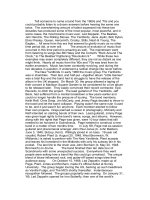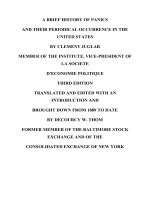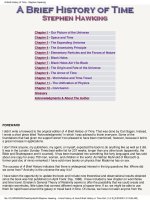- Trang chủ >>
- Khoa Học Tự Nhiên >>
- Vật lý
a brief history of the paradox philosophy and the labyrinths of the mind dec 2003
Bạn đang xem bản rút gọn của tài liệu. Xem và tải ngay bản đầy đủ của tài liệu tại đây (2.65 MB, 415 trang )
A BRIEF HISTORY
of the
Paradox
This page intentionally left blank
A BRIEF HISTORY
of the
Paradox
PHILOSOPHY AND THE
L
ABYRINTHS OF THE MIND
Roy Sorensen
2003
Oxford New York
Auckland Bangkok Buenos Aires Cape Town Chennai
Dar es Salaam Delhi Hong Kong Istanbul Karachi Kolkata
Kuala Lumpur Madrid Melbourne Mexico City Mumbai Nairobi
São Paulo Shanghai Taipei Tokyo Toronto
Copyright © 2003 by Oxford University Press, Inc.
Published by Oxford University Press, Inc.
198 Madison Avenue, New York, New York 10016
www.oup.com
Oxford is a registered trademark of Oxford University Press
All rights reserved. No part of this publication may be reproduced, stored
in a retrieval system, or transmitted, in any form or by any means,
electronic, mechanical, photocopying, recording, or otherwise, without the
prior permission of Oxford University Press.
Library of Congress Cataloging-in-Publication Data
Sorensen, Roy. A.
A brief history of the paradox: philosophy and the labyrinths
of the mind/ Roy Sorensen.
p. cm.
Includes bibliographical references and index.
ISBN 0-19-515903-9
1. Paradox. 2. Paradoxes. I. Title.
BC199.P2S67 2003
165—dc21 2003048631
Permission to print V. Alan White’s “Antimony” kindly granted by the author.
Book design by planettheo.com
9 8 7 6 5 4 3 2 1
Printed in the United States of America
on acid-free paper
To
those who never
have a book dedicated to them.
There are two famous labyrinths where our reason very often
goes astray: one concerns the great question of the Free and
the Necessary, above all in the production and the origin of
Evil; the other consists in the discussion of continuity and of
the indivisibles which appear to be the elements thereof, and
where the consideration of the infinite must enter in. The
first perplexes almost all the human race, the other exercises
philosophers only.
—Gottfried Leibniz, Theodicy
Here and elsewhere we shall not obtain the best insight into
things until we actually see them growing from the begin-
ning . . .
—Aristotle, Politics
This page intentionally left blank
Contents
List of Figures ix
Preface xi
ONE
Anaximander and the Riddle of Origin 1
TWO
Pythagoras’s Search for the Common Denominator 19
THREE
Parmenides on What Is Not 28
FOUR
Sisyphus’s Rock and Zeno’s Paradoxes 44
FIVE
Socrates: The Paradox of Inquiry 58
SIX
The Megarian Identity Crisis 71
SEVEN
Eubulides and the Politics of the Liar 83
EIGHT
A Footnote to “Plato” 100
NINE
Aristotle on Fatalism 116
TEN
Chrysippus on People Parts 130
ELEVEN
Sextus Empiricus and the Infinite Regress of Justification 148
TWELVE
Augustine’s Pragmatic Paradoxes 162
THIRTEEN
Aquinas: Can God Have a Biography? 177
FOURTEEN
Ockham and the Insolubilia 187
FIFTEEN
Buridan’s Sophisms 200
SIXTEEN
Pascal’s Improbable Calculations 216
SEVENTEEN
Leibniz’s Principle of Sufficient Reason 237
EIGHTEEN
Hume’s All-Consuming Ideas 252
NINETEEN
The Common Sense of Thomas Reid 268
TWENTY
Kant and the Antinomy of Pure Reason 284
TWENTY-ONE
Hegel’s World of Contradictions 303
TWENTY-TWO
Russell’s Set 316
TWENTY-THREE
Wittgenstein and the Depth of a Grammatical Joke 333
TWENTY-FOUR
Quine’s Question Mark 349
Bibliography 373
Index 381
List of Figures
1.1 Canadian flag 7
1.2 Penrose triangle 8
2.1 Pythagorean gnomon 23
2.2 Home plate 24
4.1 Zeno’s sphere: stage one 46
4.2 Zeno’s sphere: stage two 46
4.3 Zeno’s sphere: stage three 46
4.4 The stadium 50
5.1 Shadow block 67
8.1 Impossible crate 110
9.1 Lord Dunsany’s chess problem 117
10.1 Jigsaw people 131
16.1 Three gears 220
16.2 Four gears 220
17.1 Bertrand’s 1/3 solution 247
17.2 Bertrand’s 1/4 solution 247
17.3 Bertrand’s 1/2 solution 248
20.1 Subjective contour 297
22.1 Listing all the fractions 322
22.2 Self-mapping of the reals 323
22.3 The infinite square 324
22.4 The diagonal diagram 325
This page intentionally left blank
Preface
Mathematicians characterize prime numbers as their atoms
because all numbers can be analyzed as products of the
primes. I regard paradoxes as the atoms of philosophy
because they constitute the basic points of departure for
disciplined speculation.
Philosophy is held together by its questions rather than
by its answers. The basic philosophical questions come from
troubles within our ordinary conceptual scheme. These par-
adoxes bind generations together with common problems and
an accumulating reservoir of responses.
Philosophy is generally presented in terms of its issues
or in terms of its history. A study of the history of paradoxes
provides an opportunity to practice both approaches simul-
taneously.
This book is guided by an anthropological hypothesis:
paradoxes developed from the riddles of Greek folklore (as
did the oracles of Delphi, Christian catechisms, and the game
of charades). Accordingly, I begin classically with the Greek
philosophers. They refined informal verbal dueling into
“dialectic,” the procedure best known through Plato’s dia-
logues. The efforts of the Greeks were improved in turn,
yielding contemporary logic and dialectical conceptions of
history and science.
xii PREFACE
Paradoxes are questions (or in some cases, pseudoques-
tions) that suspend us between too many good answers.
When an amoeba divides in two, does it go out of existence?
On the one hand, organisms can survive the loss of half of
their bodies. The only problem with the mother amoeba is
that she has been too successful; instead of losing half her
body as a dead tissue, she has created a second healthy
amoeba. On the other hand, amoeba reproduction seems
like suicide because there is nothing to survive as. It would
be arbitrary to identify the mother amoeba with just one of
her daughters. And to say that the mother amoeba continues
as the pair of daughters conflicts with the idea that organ-
isms are unified individuals.
Typically, the case for one solution to a paradox looks
compelling in isolation. The question is kept alive by the tug
of war between evenly matched contestants. The Greeks were
intrigued by surprising, enduring oppositions such as these.
Common sense may seem like a seamless, timeless whole.
But it really resembles the earth’s surface; a jigsaw puzzle of
giant plates that slowly collide and rub against each other.
The stability of terra firma is the result of great forces and
counterforces. The equilibrium is imperfect; there is constant
underlying tension and, occasionally, sudden slippage. Para-
doxes mark fault lines in our common-sense world.
Do these fissures reach into reason itself? Many philos-
ophers urge us to follow the argument wherever it leads; in
the case of Socrates, even to death. But what do we do when
compelling arguments lead us in conflicting directions?
One radical response, pioneered by Heraclitus, is to
accept the reality of contradictions. He thinks the paradoxes
are out there. This line of thought has been extended by
PREFACE xiii
Hegel, Marx, and nowadays, by the dialethic logicians of
Australia.
At the other extreme are those who trace our inconsis-
tency to reliance on our senses. Parmenides dismisses the
appearance of there being many things that are changing and
moving. He conceived of reality as a single, unified whole.
Zeno’s paradoxes were intended to reinforce Parmenides’s
conclusion by extracting absurdities from common sense.
Most philosophers are moderates who try to reconcile
perception with reason. Democritus’s compromise was a
changing universe of complex objects built up from unchang-
ing, indivisible atoms moving about in the void. Rationalists
pitch the negotiation in reason’s favor. They trace paradoxes to
shortages of a priori insights. With the rise of science, empiri-
cists have driven a hard bargain in the opposite direction. They
trace paradoxes to a glut of misinformation. If we could cleanse
ourselves of superstition and subtler contaminants, we would
gain the patience needed to answer what riddles can be
answered and the maturity to admit ignorance when at the
outer range of our senses. Paradoxes have both shaped and been
shaped by the classic debate between rationalists and empiri-
cists. A faithful portrayal of paradoxes situates them in their
natural intellectual environments. Without this background,
they take on the appearance of circus animals.
I concede that paradoxes sometimes ought to be studied
in isolation. Logicians and mathematicians routinely assem-
ble paradoxes in a clinical setting. Antinomies, paralogisms,
and sophisms are stood before the reader like draftees at a
mass medical screening. Much has been learned by analytical
methods that ignore the bigger picture. But why always
ignore the bigger picture?
xiv PREFACE
In any case, I am interested in the developmental and
antiquarian aspects of paradoxes. Consequently, my approach
is more leisurely. Although I have my own theory of para-
doxes, my general intent is to have the paradoxes enter at
their own initiative and in their original order.
The deepest paradoxes are extroverts, naturally good at
introducing themselves. These challenges to compulsory,
universal beliefs are self-illuminating; they stimulate us to
draw distinctions and formulate hypotheses that bear on the
issue of how we ought to react to paradoxes. Is common sense
ever mistaken? Are paradoxes symptoms of the frailties of
human reason? Do they point to ineffable truths? When is it
rational to ignore arguments?
When Aristotle’s nephew Callisthenes volunteered to
record the expedition of Alexander the Great, he had to follow
the impetuous Alexander into situations that invited miscal-
culation. The discoverers of paradoxes expose their historians
to a parallel danger. From what appears to be a safe distance,
I see the inquirer crane his head for a better look, eventually
placing one foot on one solid-looking principle and the other
foot on a second principle that is actually incompatible with
the first. In my eagerness to document his insecure footing, I
risk misstep myself. In the following pages, I take this chance
over and over, across two millennia. Sooner or later, I must
share the fate of those I chronicle. I apologize for these errors
but am grateful to those who led me up to a position to make
them.
I also have more specific acknowledgments. I thank the
editor of Mind for permission to reprint, in chapter one, a
portion of “The Egg Came Before the Chicken,” Mind 101/
403 (July 1992): 541-42. I am grateful to V. Alan White for
PREFACE xv
permission to quote “Antinomy” from his website devoted to
philosophy songs at www.manitowoc.uwc.edu/staff/
awhite/phisong.htm. Finally, I thank colleagues and my
students at Dartmouth College for their comments and
suggestions on earlier drafts of this book.
This page intentionally left blank
A BRIEF HISTORY
of the
Paradox
This page intentionally left blank
ONE
Anaximander and the
Riddle of Origin
“ . . . 5, 1, 4, 1, 3—Done!” exclaims a haggard old man.
“You look exhausted, what have you been doing?”
“Reciting the complete decimal expansion of π back-
wards.”
So goes one of Ludwig Wittgenstein’s philosophical
jokes. A beginningless individual borders on contradiction.
Yet philosophy itself may have begun by embracing this
absurdity. For this is Anaximander’s (ca. 610
B.C.–585 B.C.)
solution to the first paradox in recorded history.
WHERE DO WE COME FROM?
People are interested in tracing their ancestral lines. Anaxi-
mander generalized this curiosity. He notes that each human
being begins as a baby who survives only if nurtured. Anaxi-
mander infers that the first human beings were cared for by
2 A BRIEF HISTORY OF THE PARADOX
animals. The Greeks knew of sharks that gave birth to live,
autonomous young. Anaximander conjectured that the first
human beings were born from aquatic creatures who then
reared them.
But where did our animal ancestors come from? Here
again, Anaximander seems ahead of his time. He infers that
these creatures had inanimate precursors.
What were the precursors of those precursors? However
long we continue the series, it makes sense to ask, what
happened before that? Yet it seems impossible for history to
be without a beginning. Isn’t that the point of Wittgenstein’s
joke?
Perhaps some of Anaximander’s contemporaries tried to
precisely formulate the absurdity as an impossible wait: If
there is an infinite past, then an infinite amount of time
would have had to elapse to reach the present moment. An
infinite wait is endless. But here we are at the present
moment! Therefore, the past must have a beginning.
Unlike Anaximander, readers of this book are at home
with negative numbers. We can model an infinite past by
letting 0 represent the present moment, -1 represent yester-
day, -2 the day before yesterday, and so on. For us, the fact
that there are infinitely many numbers before 0 does not raise
a mystery about how 0 can be reached. Why should an infinite
past be any more puzzling than the infinite sequence of
negative integers?
This mathematical model seems apt for an infinite
future. +1 could be tomorrow, +2 could represent the day
after tomorrow, and so on. You can imagine encountering an
immortal destined to count forever. Each positive integer will
be counted by this number god.
ANAXIMANDER AND THE RIDDLE OF ORIGIN 3
But negative numbers are not enough to solve the
paradox of origin. There is a “something from nothing” feel
about the claim to have recited infinitely many digits.
WHAT IS A PARADOX?
When discussing whether the barbarians originated philoso-
phy, Diogenes Laertius reports, “As to the Gymnosophists
and Druids we are told that they uttered their philosophy in
riddles . . . “ I take paradoxes to be a species of riddle. The
oldest philosophical questions evolved from folklore and
show vestiges of the verbal games that generated them.
Seduction riddles are constructed to make a bad answer
appear as a good answer. How much dirt is in a hole two
meters wide, two meters long, and two meters deep? This
question entices us to answer, eight cubic meters of dirt. The
riddler then reminds us that no dirt is in a hole.
Mystery riddles, in contrast, appear to have no answer.
One way to achieve this aura of insolubility is by describing
an object in an apparently contradictory way. As a boy,
Anaximander must have been asked the ancient Greek riddle,
“What has a mouth but never eats, a bed but never sleeps?”
(Answer: A river.) Literary riddles elaborate the genres found
in folklore. Anaximander probably learned of the riddle of
the Sphinx from Hesiod’s Theogony. We know it best from
Sophocles’ play Oedipus the King. The Sphinx is a monster
who challenges travelers with a riddle she learned from the
Muses: “What goes on four legs in the morning, two legs in
the afternoon, three legs in the evening?” She wants her
victims to remain ignorant of the underlying metaphors.
4 A BRIEF HISTORY OF THE PARADOX
Oedipus answers by decoding the question: At the dawn of
life, a baby begins life on all fours, then learns to walk upright
on two legs, and finally spends his twilight years hobbling
around with a cane. Tragically, Oedipus fails to solve deeper
question of his own origin (continuously posed by the blind
prophet Tiresias in his “riddling speech”).
With most mystery riddles, there is little hope of under-
standing the question until after the answer is revealed. Two
weeks before flying a plane into one of the World Trade
Center’s towers, Mohammed Atta phoned Ramzi Binalshibh
asking help with a riddle: Two sticks, a dash and a cake with
a stick down—what is it? Binalshibh was baffled. After the
attack on September 11, he realized that two sticks stand for
11, a dash is a dash and a cake with a stick down signifies 9.
Sometimes the riddler himself is in the dark. When the
Mad Hatter asks Alice, “Why is a raven like a writing desk?,”
he has no idea of what the answer is. Neither did the creator
of the Mad Hatter, the logician Lewis Carroll.
The poser of a paradox need not drape its meaning
behind ambiguities and metaphor. He can afford to be open
because the riddle works by overburdening the audience with
too many good answers. Consider the folk paradox, “Which
came first, the chicken or the egg?” The egg answer is backed
by an apparently compelling principle: Every chicken comes
from an egg. The trouble is that there is an equally compel-
ling principle supporting the opposite answer: Every egg
comes from a chicken.
Bodies of conflicting evidence are usually unstable. Our
ambivalence gets washed away by further witnesses, new
measurements, and recalculations. In contrast, paradoxes are
exceptionally bouyant. Whenever one side seems to prevail,
balance is restored by a counterdevelopment. From engineer-
ANAXIMANDER AND THE RIDDLE OF ORIGIN 5
ing, we know that this kind of dynamic equilibrium is most
simply achieved by symmetry. When two boards are propped
up against each other (like this: /\), their equal but opposed
forces keep the pair standing. This symmetry is evident in the
chicken or egg riddle. But we will also encounter more
complex configurations.
The Greeks were fascinated by antagonistic struggle.
They admired questions that are sustained by a balance of
power between rival answers. Their playwrights became
adept at smelting the ore of paradoxes.
The paradox lover delights in an unexpectedly even
match—especially when his audience can foretell the right-
ful outcome. Children know the answers to Zeno’s paradoxes
of motion: Can you walk out of a room? Can an arrow travel
through the air? If a slow tortoise is given a small head start,
can the fleet-footed Achilles overtake the tortoise? Zeno
confounds his audience by arguing logically for a no answer
to each of these questions. Like Lewis Carroll’s Alice, children
know “there is a mistake somewhere”—but they cannot
quite put their fingers on it.
Paradoxes can often be “dissolved” by showing that a
precondition for a solution fails to hold. Developers of the
logic of questions define a direct answer as an answer that
offers exactly as much information as the questioner
requested, neither more nor less. When I ask, “Was Anaxi-
mander or his teacher Thales the first Greek to map the
stars?” I present you with two direct answers and request that
you pick the correct answer (or a correct answer). You
completely comply with my request by asserting, “Anaxi-
mander was the first Greek to map the stars.” In a fill-in-the-
blank question, such as “What is the ratio of the earth’s height
to its diameter?” you are presented with an infinite range of
6 A BRIEF HISTORY OF THE PARADOX
values. Anaximander chose “The ratio of the earth’s height
to its diameter is 1:3.” (Anaximander thought that the earth
had the shape of a dog’s water bowl; a cylinder, curved in at
the top to prevent spillage.) If none of the direct answers to
the question are true, you can only truthfully respond by
challenging the presupposition that one of the direct answers
is correct.
Parts of a riddle are sometimes identified as the paradox:
the most surprising possible answer or the support for that
answer or even the whole set of possible answers.
Gareth Matthews, for instance, defines a paradox as a
statement that conflicts with a conceptual truth. His example
is the Stoic doctrine that those and only those are free who
know that they are not free.
Most philosophers agree arguments play an essential role
in paradox. R. M. Sainsbury identifies the paradox with the
unacceptable conclusion of an argument that has acceptable
premises and an acceptable inference pattern. J. L. Mackie
says the paradox is the whole argument.
The remaining philosophers say a paradox is a set of
individually plausible but jointly inconsistent propositions.
According to Nicholas Rescher, philosophical positions can be
classified as different ways of solving the paradox by rejecting
a member of the set. This set could be considered as the
answer set of a tidier paradox whose form is, Which, if any,
of the following propositions is true? This useful format has
no presuppositions and so limits the respondent’s options to
direct answers. The Greeks invented this tool and I regularly
employ it in this book.
Although I think paradoxes are riddles, I also think parts
of a paradox can be called paradoxes in the same spirit that
parts of a rose can be called a rose. A rose is a shrub of the









